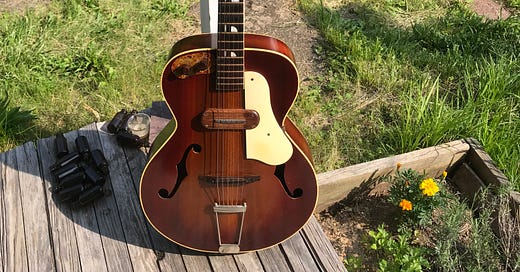In the summer of 1987, snooping around my grandparents’ Philadelphia row house while I was supposed to be helping with the install of an a/c window unit, I found a dusty guitar case beside a box of old newspapers stashed away under a bed.
The guitar case itself was of flimsy construction, but had a relief pattern on the topside that looked like turtle shell. I slid the case out from under the bed, unlatched the three rusted latches, and lifted the lid.
Inside was a pristine old archtop with rusted strings.
Years later, I would do some amateur internet sleuthing and find that this was likely a Kay-manufactured archtop marketed under the Silvertone brand and sold by Sears in the late 1940s or early 50s. I’ve found similar models, but never with the same pickup — it appears to be just a single bar magnet.
At one point, I wondered if my grandfather had fashioned the pickup mount himself (he was a tinkerer), but I’ve found a few similar examples. It’s striking in its simplicity.
Anyway, as a 13 year old, the only thing I saw was electricity. I immediately pulled the guitar from the case, gave it my best strum, and a string promptly snapped and stung me in the forehead.
I was in love.
This was the first guitar I ever played in a band. A few of us gathered in the basement of my old house — drums and three guitar players, if I recall correctly. I plugged into a Fender Champ and cranked it.
Pure feedback bliss.
I’m pretty sure the first song we played was ‘Wild Thing’. We might have played it multiple times that afternoon because it was the only song that all of us knew how to play.
I’d have many guitars over the years. There was my first plywood acoustic that I wrote much of my music on for the first 15 or so years of being a musician. There was a new Fender Stratocaster that I bought in 1989 — it was later stolen by hopped-up rave kids. There was a 60s Fender Duo Sonic that I borrowed from a bounty hunter. A white SG that I never learned how to string or keep in tune. A cheap Epiphone jumbo and a really expensive Taylor jumbo. A couple Dean metal guitars. Another Strat that I used for one tour and then promptly sold for a custom Breedlove acoustic. An old Hohner that felt like it was made out of paper. A fake Tele, a real Tele, and then no Tele. Yet another Strat that I borrowed while playing in a honky-tonk band — this one only had a single working pickup, but it was a Lindy Fralin so go figure. A Taylor dreadnought that would be smashed by Scandinavian Airlines en route to a festival in Sweden. A nice Martin dreadnought that’s currently my go-to for playing around the house or out in the woods. An Epiphone Sheraton that I swear has a better neck than any Gibson I’ve ever played. And my current number one — a Strat that I put together from the ground up starting with having a carpenter build me a custom body.
But the Silvertone I found under the bed in my grandparents’ house still wins out as the coolest guitar on the planet.
It’s got super thin copper frets (I’ve read that these were standard for some guitars during and following WWII on account of steel rationing… no idea if that is true). And the neck is a super-deep U shape. The action is high… and there is no simple way to adjust without moving the bridge and potentially damaging the finish.
But the electric bits still work and the tone knob is surprisingly subtle given the primitive nature of the pickup. The guitar feels small for an archtop — which I appreciate as there is less fatigue on your arm and elbow. And the binding and pickguard have developed a patina that you can just melt into.
All in all, it’s a guitar that in someways is extraordinarily challenging to play. But it was the guitar that I learned on, and therefore I developed some techniques early that have stuck with me even today and which probably lend some unique character to my approach whether playing heavy music, jazz, whatever.
I don’t know whatever happened to that Fender Champ amp. But I can recall the sound in my bones. The howl of feedback. The resonance of the guitar vibrating in my arms. The electricity.







